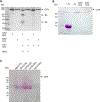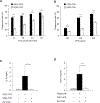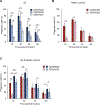Genetic coding variant in complement factor B (CFB) is associated with increased risk for perianal Crohn's disease and leads to impaired CFB cleavage and phagocytosis
- PMID: 37080587
- PMCID: PMC11036449
- DOI: 10.1136/gutjnl-2023-329689
Genetic coding variant in complement factor B (CFB) is associated with increased risk for perianal Crohn's disease and leads to impaired CFB cleavage and phagocytosis
Abstract
Objective: Perianal Crohn's disease (pCD) occurs in up to 40% of patients with CD and is associated with poor quality of life, limited treatment responses and poorly understood aetiology. We performed a genetic association study comparing CD subjects with and without perianal disease and subsequently performed functional follow-up studies for a pCD associated SNP in Complement Factor B (CFB).
Design: Immunochip-based meta-analysis on 4056 pCD and 11 088 patients with CD from three independent cohorts was performed. Serological and clinical variables were analysed by regression analyses. Risk allele of rs4151651 was introduced into human CFB plasmid by site-directed mutagenesis. Binding of recombinant G252 or S252 CFB to C3b and its cleavage was determined in cell-free assays. Macrophage phagocytosis in presence of recombinant CFB or serum from CFB risk, or protective CD or healthy subjects was assessed by flow cytometry.
Results: Perianal complications were associated with colonic involvement, OmpC and ASCA serology, and serology quartile sum score. We identified a genetic association for pCD (rs4151651), a non-synonymous SNP (G252S) in CFB, in all three cohorts. Recombinant S252 CFB had reduced binding to C3b, its cleavage was impaired, and complement-driven phagocytosis and cytokine secretion were reduced compared with G252 CFB. Serine 252 generates a de novo glycosylation site in CFB. Serum from homozygous risk patients displayed significantly decreased macrophage phagocytosis compared with non-risk serum.
Conclusion: pCD-associated rs4151651 in CFB is a loss-of-function mutation that impairs its cleavage, activation of alternative complement pathway, and pathogen phagocytosis thus implicating the alternative complement pathway and CFB in pCD aetiology.
Keywords: IBD - GENETICS; INFLAMMATORY BOWEL DISEASE; META-ANALYSIS.
© Author(s) (or their employer(s)) 2023. No commercial re-use. See rights and permissions. Published by BMJ.
Conflict of interest statement
Competing interests: Cedars-Sinai has financial interests in Prometheus Biosciences, a company which has access to the data and specimens in Cedars-Sinai’s MIRIAD Biobank (including the data and specimens used in this study) and seeks to develop commercial products. DM and SRT own stock in Prometheus Biosciences. DL, SRT and DM are consultants for Prometheus Biosciences. DM has consulted for Takeda, Sandoz Immunology, Gilead, Pfizer, Boehringer Ingelheim, Qu Biologics and Bridge Biotherapeutics. CH is on the Advisory Board or consultant for Abbvie, Bristol Myers Squibb, Ferring, Genentech, InDex Pharmaceuticals, Janssen, Pfizer, Takeda, received research support from Abbvie, Genentech, Eli Lilly, Pfizer, and educational grant funding from Pfizer. PF is a consultant for Takeda. GM is a consultant for Abbvie, Arena, Boehringer-Ingelheim, Bristol-Myers Squibb, Janssen, Medtronic, Techlab, Takeda, Pfizer, Samsung Bioepis, Entasis, Ferring, Shionogi and received research funding from Pfizer.
Figures





Comment in
-
Defective microbial sensing and clearance in perianal Crohn's disease: a role for complement factor B.Gut. 2023 Nov;72(11):2010-2012. doi: 10.1136/gutjnl-2023-329801. Epub 2023 Apr 25. Gut. 2023. PMID: 37098439 No abstract available.
References
-
- Panés J, Rimola J. Perianal Fistulizing Crohn’s disease: pathogenesis, diagnosis and therapy. Nat Rev Gastroenterol Hepatol 2017;14:652–64. - PubMed
Publication types
MeSH terms
Substances
Grants and funding
LinkOut - more resources
Full Text Sources
Medical
Molecular Biology Databases
Miscellaneous
